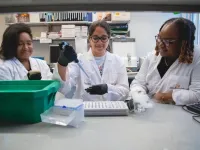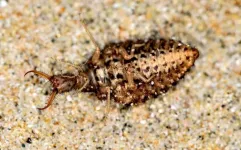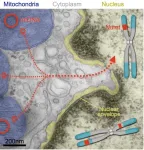(Press-News.org) UNIVERSITY PARK, Pa. — A type of drug developed for treating cancer holds promise as a new treatment for neurodegenerative diseases such as Alzheimer’s, according to a recent study by researchers at Penn State, Stanford University and an international team of collaborators.
The researchers discovered that by blocking a specific enzyme called indoleamine-2,3-dioxygenase 1, or IDO1 for short, they could rescue memory and brain function in models that mimic Alzheimer’s disease. The findings, published today (Aug. 22) in the journal Science, suggest that IDO1 inhibitors currently being developed as a treatment for many types of cancer, including melanoma, leukemia and breast cancer, could be repurposed to treat the early stages of neurodegenerative diseases — a first for the chronic conditions that lack preventative treatments.
“We’re showing that there is high potential for IDO1 inhibitors, which are already within the repertoire of drugs being developed for cancer treatments, to target and treat Alzheimer's,” said Melanie McReynolds, the Dorothy Foehr Huck and J. Lloyd Huck Early Career Chair in Biochemistry and Molecular Biology at Penn State and co-author on the paper. “In the broader context of aging, neurological decline is one of the biggest co-factors of being unable to age healthier. The benefits of understanding and treating metabolic decline in neurological disorders will impact not just those who are diagnosed, but our families, our society, our entire economy.”
Alzheimer’s disease is the most common type of dementia, an umbrella term that refers to all age-associated neurodegenerative disorders, McReynolds explained. In 2023, as many as 6.7 million Americans were living with Alzheimer’s disease, according to the Centers for Disease Control and Prevention, and its prevalence is expected to triple by 2060.
“Inhibiting this enzyme, particularly with compounds that have been previously investigated in human clinical trials for cancer, could be a big step forward in finding ways to protect our brains from the damage caused by aging and neurodegeneration,” said Katrin Andreasson, the Edward F. and Irene Pimley Professor of Neurology and Neurological Sciences at the Stanford University School of Medicine and the study’s senior author.
Alzheimer’s disease affects the parts of the brain that control thought, memory and language, the result of progressive and irreversible loss of synapses and neural circuitry. As the disease progresses, symptoms can increase from mild memory loss to losing the ability to communicate and respond to the environment. Current treatments for the disease are focused on managing symptoms and slowing progression, through targeting the build-up of amyloid and tau plaques in the brain, but there are no approved treatments for combating the onset of the disease, McReynolds said.
“Scientists have been targeting the downstream effects of what we identify as an issue with the way the brain powers itself,” said Praveena Prasad, doctoral student at Penn State and co-author on the paper. “The therapies that are currently available are working to remove peptides that are likely the result of a bigger issue we can target before those peptides can start forming plaques. We’re demonstrating that by targeting the brain’s metabolism, we can not only slow, but reverse the progression of this disease.”
Using preclinical models — in vitro cellular models with amyloid and tau proteins, in vivo mouse models and in vitro human cells from Alzheimer’s patients — the researchers demonstrated that stopping IDO1 helps restore healthy glucose metabolism in astrocytes, the star-shaped brain cells that provide metabolic support to neurons.
IDO1 is an enzyme that breaks down tryptophan, the same molecule in turkey that can make you sleepy, into a compound called kynurenine. The body’s production of kynurenine is the first part of a chain reaction known as the kynurenine pathway, or KP, which plays a critical role in how the body provides cellular energy to the brain. The researchers found that when IDO1 generated too much kynurenine, it reduced glucose metabolism in astrocytes that was required to power neurons. With IDO1 suppressed, metabolic support for neurons increased and restored their ability to function.
The researchers conducted the study in several models of Alzheimer’s pathology, namely amyloid or tau accumulation and found that the protective effects of blocking IDO1 cut across these two different pathologies. Their findings suggest that IDO1 may also be relevant in diseases with other types of pathology, such as Parkinson’s disease dementia as well as the broad spectrum of progressive neurodegenerative disorders known as tauopathies, explained Paras Minhas, current resident at Memorial Sloan Kettering Cancer Center who earned a combined medical and doctoral degree in neuroscience at Stanford School of Medicine and is first author on the paper
“The brain is very dependent on glucose to fuel many processes, so losing the ability to effectively use glucose for metabolism and energy production can trigger metabolic decline and, in particular, cognitive decline,” Minhas said. “Through this collaboration we were able to visualize precisely how the brain’s metabolism is impacted with neurodegeneration.”
The other Penn State author is lab manager Brenita Jenkins. Other co-authors are Amira Latif-Hernandez, Aarooran S. Durairaj, Qian Wang, Siddhita D. Mhatre, Travis Conley, Hannah Ennerfelt, Yoo Jin Jung, Edward N. Wilson, Frank M. Longo, Takeshi Uenaka and Marius Wernig of Stanford University; Jeffrey R. Jones, Ryan Goodman, Traci Newmeyer, Kelly Heard, Austin Kang and Fred H. Gage of The Salk Institute for Biological Studies; Yuki Sugiura and Makoto Suematsu of Keio University; Ling Liu and Joshua D. Rabinowitz of Princeton University; Erik M. Ullian of the University of California San Francisco; Geidy E. Serrano and Thomas G. Beach of the Banner Sun Health Research Institute.
The Howard Hughes Medical Institute Hanna H. Gray Fellows Program Faculty Phase and the Burroughs Welcome Fund PDEP Transition to Faculty funded the Penn State aspects of this work.
END
Cancer drug could treat early-stage Alzheimer’s disease, study shows
2024-08-22
ELSE PRESS RELEASES FROM THIS DATE:
Drugs that improve brain metabolism could help Alzheimer’s patients
2024-08-22
Among the many ways neuroscientists think Alzheimer’s disease may strip away brain function is by disrupting the glucose metabolism needed to fuel the healthy brain. In essence, declining metabolism robs the brain of energy, impairing thinking and memory.
Against that backdrop, a team of neuroscientists at the Knight Initiative for Brain Resilience at Stanford’s Wu Tsai Neurosciences Institute have zeroed in on a critical regulator of brain metabolism known as the kynurenine pathway. They hypothesize that that the kynurenine pathway is overactivated as a result of ...
Life after (feigned) death
2024-08-22
A new study led by scientists from the University of Bristol has revealed what animals do after they have feigned death in order to avoid being killed by a predator and what the context of this behaviour is.
Many animals, as a last-ditch defence, become motionless after being contacted by a predator.
This behaviour is so common that it's recognised in such phrases as “playing possum”. It is even said to occur in humans in extreme circumstances.
In previous studies, carried out by the same team using antlion larvae, scientists noticed that they become motionless after being individually handled.
At one point ...
Fisheries research overestimates fish stocks
2024-08-22
Many fish stocks around the world are either threatened by overfishing or have already collapsed. One of the main reasons for this devastating trend is that policymakers have often ignored the catch limits calculated by scientists, which were intended to be strict thresholds to protect stocks. But it has now become clear that even these scientific recommendations were often too high.
In the European Union (EU), for example, fisheries are primarily managed through allowable catch limits, known as quotas, which are set by the European ...
AI tackles one of the most difficult challenges in quantum chemistry
2024-08-22
New research using neural networks, a form of brain-inspired AI, proposes a solution to the tough challenge of modelling the states of molecules.
The research shows how the technique can help solve fundamental equations in complex molecular systems.
This could lead to practical uses in the future, helping researchers to prototype new materials and chemical syntheses using computer simulation before trying to make them in the lab.
Led by Imperial College London and Google DeepMind scientists, the study is published today in Science.
Excited molecules
The team investigated the problem of understanding ...
Mitochondria are flinging their DNA into our brain cells
2024-08-22
NEW YORK, NY (Aug. 22, 2024)--As direct descendants of ancient bacteria, mitochondria have always been a little alien.
Now a study shows that mitochondria are possibly even stranger than we thought.
Mitochondria in our brain cells frequently fling their DNA into the nucleus, the study found, where the DNA becomes integrated into the cells’ chromosomes. And these insertions may be causing harm: Among the study’s nearly 1,200 participants, those with more mitochondrial DNA insertions in their brain cells ...
Revealing DNA behavior in record time
2024-08-22
“DNA, RNA and proteins are the key players to regulate all processes in the cells of our body,” Leiden Professor John van Noort explains. “To understand the (mis-)functioning of these molecules, it is essential to uncover how their 3D structure depends on their sequence and for this it is necessary to measure them one molecule at a time. However, single-molecule measurements are laborious and slow, and the number of possible sequence variations is massive.”
From decades to days
Now the team of scientists developed an innovative tool, called SPARXS (Single-molecule Parallel Analysis for Rapid eXploration ...
Columbia receives $400 million gift for biomedical research
2024-08-22
NEW YORK, NY (Aug. 22, 2024)--Columbia University announced today a new $400 million gift from Roy and Diana Vagelos, which will secure Columbia’s leadership in biomedical science research and education and produce a vast array of compelling opportunities for improving society’s health and wellbeing. The gift is the single largest ever made to Columbia’s medical school and, taken together with their previous giving, establishes Roy and Diana as the most generous donors in the history of Columbia University.
A ...
Air pollution harms mental health worse in New York’s historically redlined neighborhoods
2024-08-22
BUFFALO, N.Y. — Air pollution is bad for mental health. That much is clear. Now, new research shows the impact may be even worse in neighborhoods that were historically redlined.
University at Buffalo researchers looked at 17 cities across New York State where longstanding federal housing policies once denied neighborhoods with people of color from receiving mortgages. Although this practice was outlawed in 1968, the researchers found that elevated levels of air pollutants in these neighborhoods of the state ...
Meteor showers shed light on where comets formed in the early solar system
2024-08-22
An international team of 45 researchers studying meteor showers has found that not all comets crumble the same way when they approach the Sun. In a paper published in the journal Icarus this week, they ascribe the differences to the conditions in the protoplanetary disk where comets formed 4.5 billion years ago.
“The meteoroids we see as meteors in the night sky are the size of small pebbles,” said lead author and SETI Institute and NASA Ames meteor astronomer Peter Jenniskens. “They are, in fact, the same size as the pebbles that collapsed into comets during the formation of ...
ChatGPT shows promise in answering patients' questions to urologists
2024-08-22
August 22, 2024 — The groundbreaking ChatGPT chatbot shows potential as a time-saving tool for responding to patient questions sent to the urologist's office, suggests a study in the September issue of Urology Practice®, an Official Journal of the American Urological Association (AUA). The journal is published in the Lippincott portfolio by Wolters Kluwer.
The artificial intelligence (AI) tool generated "acceptable" responses to nearly one-half of a sample of real-life patient questions, according to the new research ...








